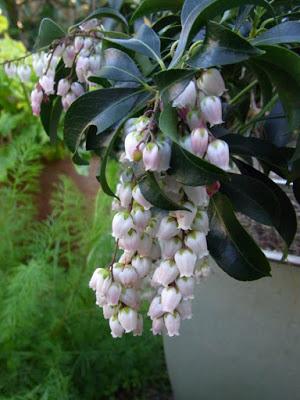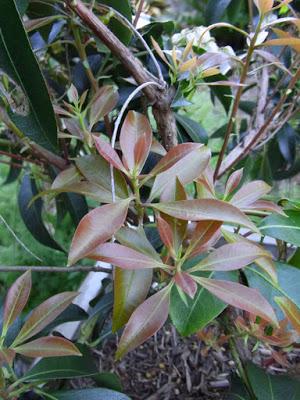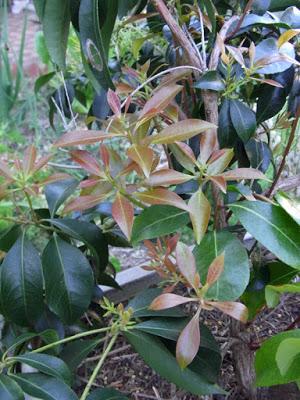"It's not a garden, it's a hospital ward." That's how one friend described her garden full of sick plants, and I have thought of her during the last few months while I have been nursing our sick Pieris japonica back to health. Beneath my veneer of seeming to be an organic goody two-shoes, I tend to be quite a ruthless gardener. Sure, I'll tend to unwell plants for a while, but if they seem like a hopeless case, then out they go.
But not the Pieris. It's one of "Pammy's plants" and so I am duty-bound to do my best with it. She brought it home one day, from a local florist's shop, and handed it to me to add to our garden. Nice plant, but deep down I suspected it'd be trouble ...

Here's the patient in full bloom this morning. The glossy green leaves look pretty healthy, too, so what's the problem?
The other half of the plant is dead. In fact a few months ago I cut off the whole back half of the plant as it was dying rapidly. This left us with an ugly, lop-sided patient to care for, but the good news is that there are signs of hope!

Here's the lush bronze hope-inspiring foliage sprouting all over the back half of our Pieris.

When Pammy brought the Pieris home last year I knew I was in for a challenge to keep this plant happy. You will occasionally see healthy Pieris growing in Sydney gardens, so it's not impossible, but my starting point was knowing that this plant prefers cooler climates than Sydney's. Pieris does better further south and up in the mountains.
So I decided to keep it in a biggish pot, and place the pot in a warmer spot in winter, but a cooler spot in summer. Whatever I did was wrong, as half the plant died off over the summer. I cut out all the dead bits, then moved the pot to a sunnier spot for the winter, and plied the plant with seaweed solution every four weeks. The seaweed (eco-seaweed) is not a fertiliser. It's a plant tonic that encourages roots to grow, and generally lowers stress in sick plants.
I also kept up the water to the pot, without water logging it, and finally it started to show some growth as the spring warmth arrived.
One tip with sick plants is NOT to feed them if they are not showing any signs of growth. Just keep adding seaweed solution. Once you see some positive signs, like new foliage, then start a gentle feeding program, and only then.
So I've given the pot a single dose of liquid organic-based feed (Powerfeed, mixed up and watered in via a watering can), and have followed that up with some slow-release fertiliser pellets that will trickle down food over the next three months. Once the summer comes on, I'm looking for a spot that gets morning sun but shade for the rest of the day.
Wish me luck. As it's Pammy's plant I am trying extra-hard to keep it happy. I feel like I'm a doctor with a tricky patient. This is not a good space for a gardener to occupy but sometimes you have to nurse plants back to health.
I'm trying everything. Pam's mum, Val, says she talks to her plants and she's a green-thumb with two verandahs full of happy plants. So I'm going to start talking to the Pieris, just in case Val is right.
